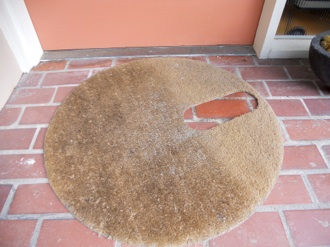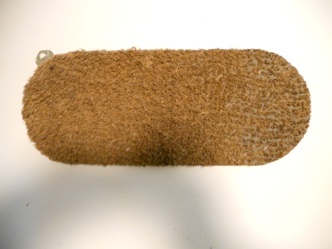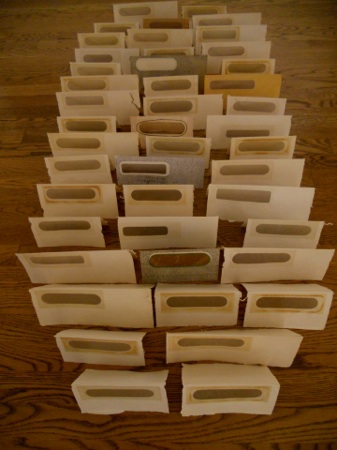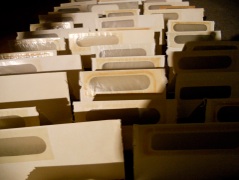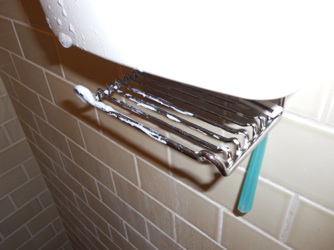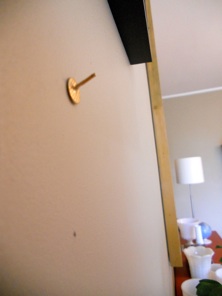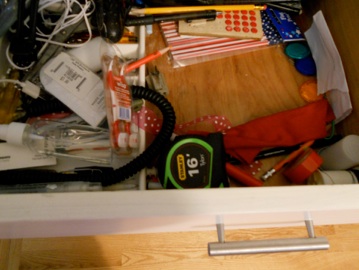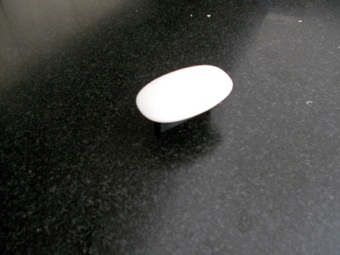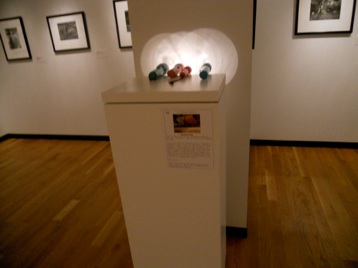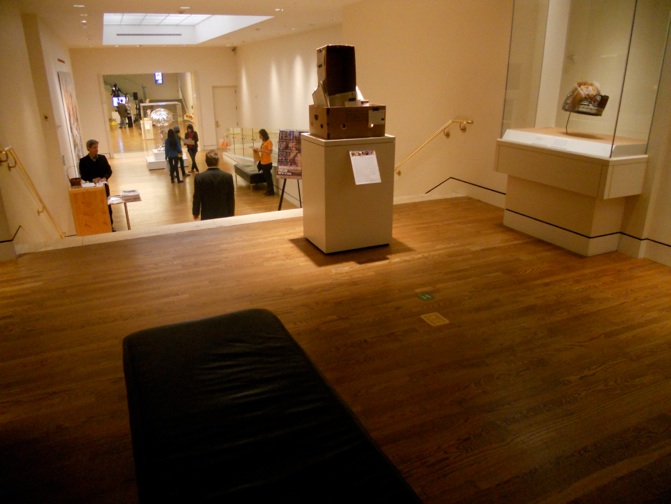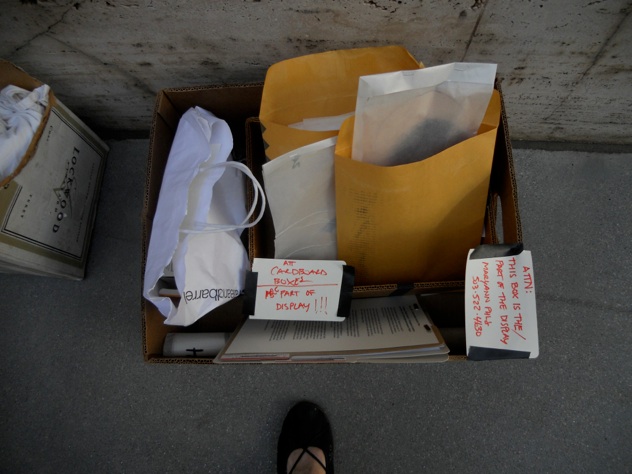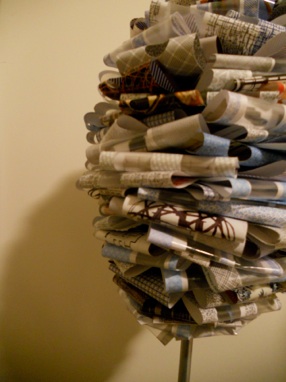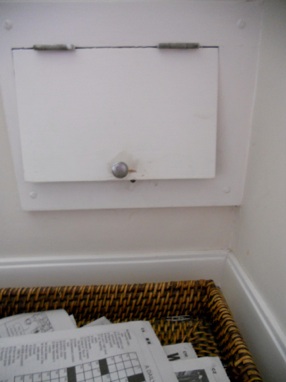[PORTLAND ART MUSEUM]
MY EXPERIENCE: After reading a blog, exchanging an email and meeting up with a stranger at the museum, I became part of a multi-participant project. The stranger, artist Sandy Sampson, is the author this project called "A Teaching Collection." For this, she requested that each participant lead her to what they were interested in seeing in the museum and share their thoughts, then later choose an object from their home to be displayed during a one-evening event at the museum.
While at the museum, I was inspired by an abstract piece, "Locations," done in 1969 by Richard Artschwager. The individual components of this piece, simple capsule-shaped forms referred to as BLIPs, are hung in unlikely places at various heights and questions the expected placement of art.
It was years ago that I first noticed a BLIP, a clear piece of plexiglass outlined in black paint, positioned high on the museum wall. At first glance I thought it was a common utilitarian object. I felt I’d "discovered" it and whatever it was, I loved it, regardless of its purpose. Finding the rest of the BLPs added to my experience.
I've used the capsule shape in my own work. The flattened form reads like an elongated punctuation mark or place mark, a stamp of proof, a finger print, a solid cut-out, like a core sample; a single word. The shape can also be full, ovular and seed-like, a container for facts and data, or a time capsule. Each of the variant forms tells a slightly different story. Together they are very much related and work well together.
The BLIPs were prevalent in the late 70's and 80's, painted or stuck-on in various locations around New York City. Artschwager's intention was to bring the public’s attention to surfaces and structures (subway walls, smokestacks, etc) that usually go unnoticed.
The artist referred to the BLIPs as a family of marks, gestures, holes and objects of related size and shape and compared the BLIP variants to a socket wrench set. He explained, "When one is taken out of the box and attached to the handle and then the bolt, you lock the socket into its true context." To me the placement of the BLIPs are out of context, which makes them wonderful and curious inclusions. "A Teaching Collection" and Artschwager's BLIPs, both address placement and inclusion, and I was intrigued with the tool-set box idea - that each part would have a home-base and how any empty spaces would reveal an obvious displacement. Link to photo of ‘Locations’
MY RESPONSE: What object from my home would I bring to the museum, and where would I display it?
As exciting as it would be to bring in one of my own paintings or prints to show in the museum, I wanted to respond with an object that reflects the time that I had spent there that day, something new, requiring more thought. It was somewhere in my mind. If I were to respond authentically, it needed to come from there.
I responded to each of the six BLIPs with a form of my own, each made with items related to my home. In some cases as a contrast to his work and some more directly. They were placed throughout the museum for one evening.
MY RESPONSE OBJECTS / LOCATIONS
Response Object and its Museum Location: Doormat segment, key / located in lobby
Home Location: Front Porch
The Inspiration - Rubberized horsehair BLIP by Richard Artschwager:
Artschwager’s BLIP seemed to be just cleanly cut or punched out of a bigger piece of thick material which I found to be sort of comical. I responded to that part exactly. The idea of punching out a capsule shape from something in my home, exhibiting it in the museum and then replacing it later amused me.
Response Object and its Museum Location:
Collection of vintage envelopes with the glassine capsule shaped windows / The floor of the Schnitzer Center for NW Art
Home Location: Home Studio
The Inspiration - Clear flat plastic BLIP with black outline by Richard Artschwager: Placed high on the wall and the common everyday material it was made it seem like a utilitarian object.
Response Object and its Museum Location:
Magazines, windowed and security envelopes, newspapers / Hall leading to current exhibit.
Home Location: Mail slot and front porch
The Inspiration Description - Black hanging BLIP with shadow by Richard Artschwager:
I saw his hanging BLIP as solid and full. It could be a seed full of potential or a time capsule. My response, in contrast, is supported from an upright stand instead and it’s lightweight and open.
Response Object and its Museum Location:.
Three framed monoprints ‘how magnets work’ wrapped in glassine with cut-out of capsule shape revealing part of print. Positioned next to a framed piece on a pedestal by Joseph Cornell
Home Location: Dining Room Wall
The Inspiration Description - Blue framed shadow box by Richard Artschwager:
The outline of the BLIP appears as a shadow against a watery blue Formica backdrop on the Artschwager piece. This is the only BLIP that is contained and displayed in a rectangle. I responded to those features.
Response Object its Museum Location: Lever 2000 soap located on museum floor.
Home Location: Shower
The Inspiration Description - Simple flat black BLIP by Richard Artschwager:
This was the most minimalist of all the Artschwager components and I hadn't felt a connection or come up with a meaningful response for it. All along, as I responded to this project in general, I came across the capsule shape more often than I expected. I kept having that “oh there it is again” reaction. When I was searching for possible (and museum approved) locations to place my different response pieces, I noticed the shape in a naturally occurring flaw in the polished concrete floor under a sculpture. There it was again. My response would be as minimal as that.
Response Objects and its Museum Location: Flashlights / wall in the photography section.
Home Location: Kitchen junk drawer, garage and basement.
The Inspiration Description - Mirror and its reflection BLIP by Richard Artschwager:
For this project, I couldn't hang anything on the museum walls. I was able to get around that by Illuminating and reflecting the BLIP shape on the wall.
inventory Transfer Containers
I brought my response pieces to the museum loading dock in simple cardboard boxes and I my own made-to-look-real inventory references, museum-like labels. Upon bringing my pieces through the museum’s loading dock, they were photographed with actual inventory numbers.
Museum Location: with a collection of beautiful and finely crafted Native American rectangular transfer containers.
Installation inventory outside the museum loading dock
[ More images ]
